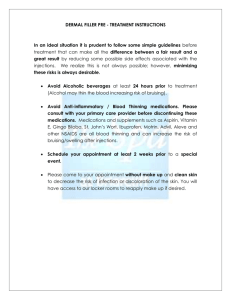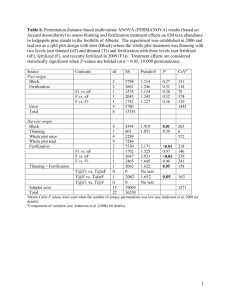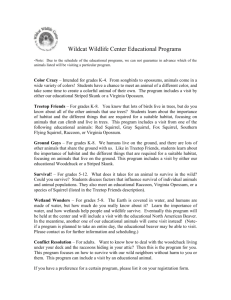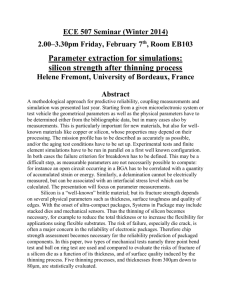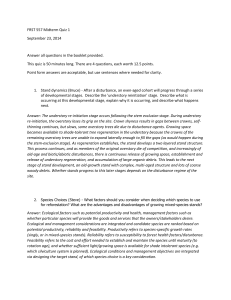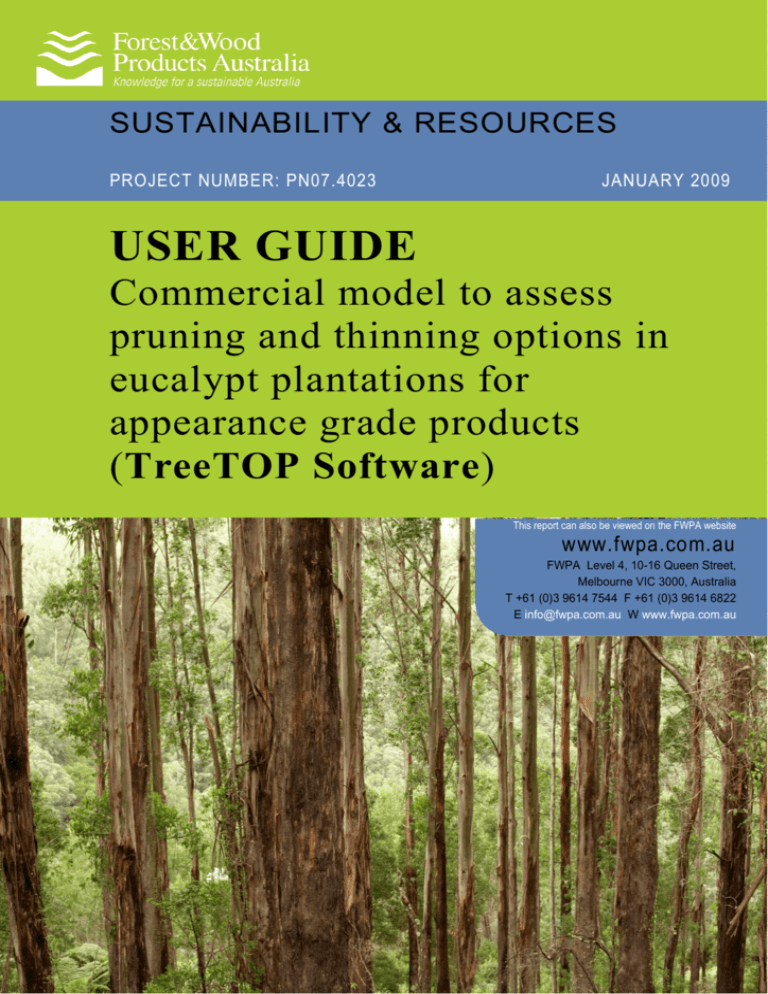
SUSTAINABILITY & RESOURCES
PROJECT NUMBER: PN07.4023
JANUARY 2009
USER GUIDE
Commercial model to assess
pruning and thinning options in
eucalypt plantations for
appearance grade products
(TreeTOP Software)
This report can also be viewed on the FWPA website
www.fwpa.com.au
FWPA Level 4, 10-16 Queen Street,
Melbourne VIC 3000, Australia
T +61 (0)3 9614 7544 F +61 (0)3 9614 6822
E info@fwpa.com.au W www.fwpa.com.au
Publication: User Guide - Commercial model to assess pruning
and thinning options in eucalypt plantations for appearance
grade products (TreeTOP Software)
Project No: PN07.4023
© 2009 Forest & Wood Products Australia Limited. All rights reserved.
Forest & Wood Products Australia Limited (FWPA) makes no warranties or assurances with
respect to this publication including merchantability, fitness for purpose or otherwise. FWPA and
all persons associated with it exclude all liability (including liability for negligence) in relation to
any opinion, advice or information contained in this publication or for any consequences arising
from the use of such opinion, advice or information.
This work is copyright and protected under the Copyright Act 1968 (Cth). All material except the
FWPA logo may be reproduced in whole or in part, provided that it is not sold or used for
commercial benefit and its source (Forest & Wood Products Australia Limited) is acknowledged.
Reproduction or copying for other purposes, which is strictly reserved only for the owner or
licensee of copyright under the Copyright Act, is prohibited without the prior written consent of
Forest & Wood Products Australia Limited.
Researcher:
Rod Meynik
rod.meynink@mbac.com.au
Forest & Wood Products Australia Limited
Level 4, 10-16 Queen St, Melbourne, Victoria, 3000
T +61 3 9614 7544 F +61 3 9614 6822
E info@fwpa.com.au
W www.fwpa.com.au
Table of Contents
Program Overview and Aim..................................................................................................................... 2
Assumptions ............................................................................................................................................ 2
User Control ............................................................................................................................................ 3
Optimum Outcomes................................................................................................................................. 3
An Example ............................................................................................................................................. 3
How to Use the Model ............................................................................................................................. 4
Species (see species list).................................................................................................................... 4
Site (see site quality attributes list) ..................................................................................................... 5
Silvics .................................................................................................................................................. 6
Costs ................................................................................................................................................... 6
Prices .................................................................................................................................................. 7
Auto Harvest Age determination ......................................................................................................... 7
Thinning and pruning regimes............................................................................................................. 8
Establish regime.................................................................................................................................. 8
Maintenance regime............................................................................................................................ 8
Benchmarking ..................................................................................................................................... 9
………………………………………………………………………………………………
1
Program Overview and Aim
TreeTOP is a generic stand growth model which has the aim of helping users decide when and
whether Tree Thinning or Pruning (Tree T.o.P) is viable. The default functions and values have been
set to approximate reasonable values based on silvicultural trials, but TreeTOP may not be highly
reliable as a yield predictor unless calibrated with user data from stands with similar species, site and
silviculture. In particular data from older pruned plantations is extremely limited, and users should treat
the model's default predictions with due caution.
The model is Microsoft Excel based, reasonably sophisticated in its thinning/pruning capabilities and
easy to use (requires some knowledge of Microsoft Excel). Instructions are included.
Please address questions relating to application of the model, via email to
rod.meynink@mbac.com.au. IT aspects of the software download are not supported.
To download software, visit FWPA website:
http://www.fwpa.com.au/treetops_disclaimer.aspx
Users should at all times be aware of this limitation and not rely primarily on TreeTOP for commercial
investment decisions.
Assumptions
To keep the model workable, it was necessary to make some simplifying assumptions. The important
ones are:
I.
Thinning always occurs from below, i.e. the weakest and smallest stems are prioritised for
removal. Hence there is a "jump" in the mean DBH after thinning.
II.
Stand basal area growth follows an S-shaped curve (Chapman-Richards function) and reaches
a maximum (asymptote) for any given site. This maximum is the value defined by site quality
SQ
III.
The stand responds to release from competition after thinning. The response depends on
species, site, age, stocking, and current DBH
IV.
Pruning does not impact negatively on tree growth. This means that the user must be careful to
specify pruning only to a height which does not remove too much green crown.
2
V.
There is no limitation of minimum viable commercial volume. If TreeTOP finds 1.2m3/ha of
sawlogs, then the stand will be valued as such even if this is not a viable extraction rate.
VI.
There are only four types of log products recognised, and their relative output proportion can be
controlled by the user based on the mean DBH of thinned trees
VII.
There are some likely growth benefits from intensive site preparation and subsequent fertilising.
User Control
Many of the cells are locked and cannot be changed by the user. This to prevent accidental overwrite.
If you want to access the cell results from another program or spreadsheet, you can refer to them by
the usual methods. Some working sheets are hidden to avoid confusion and complication. Contact
Rod Meynink [rod.meynink@mbac.com.au] if you need access to hidden sheets. Attributes which can
be changed by the user include species inherent growth rate and competition tolerance, site quality,
DBH distribution before and after thinning and product grade recoveries from different log sizes. All
attributes have some starting default values. The user has great flexibility & control over silviculture,
within the framework of three thinnings (one non-commercial), two prunings and a 50 year rotation.
Management costs and Log prices are specified directly for locally relevant markets; short cut entry
methods, slider controls and charts facilitate "what-if" testing.
Optimum Outcomes
There is no simple way to optimise the silviculture since the number of options is vast and outcomes
are non-linear. Heuristic procedures are required.
Note: although TreeTOP is a stand-level model, multiple stands or strata of uniform quality can be
aggregated to form a plantation "estate".
TreeTOP can be used to guide management of the strata so as to produce optimum outcomes and/or
even wood flows from the estate. Users who wish to use TreeTOP to investigate optimum
management in specific situations, or to generate stand tables for exporting into other applications, or
to generate multi-dimensional response surfaces for sensitivity testing, are invited to contact Rod
Meynink [rod.meynink@mbac.com.au].
An Example
Suppose a landowner and mill owner each consider the management of a plantation area so as to
meet their particular aims. The landowner’s prime commercial aim is to earn at least 5% p.a real rate
of return on the (non-land) investment. The mill owner’s prime aim is to obtain plentiful quantities of
3
low cost large diameter high quality pruned sawlogs and veneer logs in as short a space of time as
possible. What sort of silvicultural strategies should be employed?
Is it better to plant fewer trees and prune? Or plant more and thin to waste and for pulp?
Is it worth investing in intensive site preparation, or accept some loss of growth in return for reduced
start-up costs?
For either established or new stands, when is the best time to thin, and how much should be
removed?
How much increase in recovery of higher grade logs is needed to justify pruning the trees, and up to
what height and when?
How much would the mill owner have to pay in order to encourage the landowner to prune and thin?
Or, how much pruning and thinning can be viably undertaken by the landowner at current prices?
How is the answer to these questions different for low quality sites and high quality sites?
Rather than produce a specific answer here, the user can try the following steps:
1. Choose the species and the site quality.
2. Choose an intensive establishment and management regime
3. Set up a conventional silvicultural schedule for thinning
4. Open the charts and tables windows and observe the outcomes
Now try changing parameters such as the planting density and thinning and pruning intensities and
ages in the Silvis window
How to Use the Model
NOTE: enable macros to access program in Excel (found: Tools - Options - Security - Macros)
Press any of the buttons on the start page in sequence top to bottom and enter your parameters as
required. The Command Buttons on some pages are only active if that is the only window (other than
the start page) which is open. If the buttons do not work, close all windows other than the start page,
re-open the appropriate window, and press the button.
Species (see species list)
•
species selection has effects on yield outcomes through the parameters of tolerance (TOL)
and inherent growth rate (GRO)
•
Species which are more tolerant of shade and competition are assumed to have lower
mortality rates, greater number of retained branches, and less dispersed DBH frequency
distribution.
4
•
The user can assign TOL values for any species; for Myrtaceous sclerophylls including
eucalypts, the values range from 1 (light demanding, e.g. E.grandis, E. regnans) to (4)
moderately shade tolerant (E.microcorys, Lophostemon confertus).
•
TOL need not be an integer; TreeTOP can accept TOL values from 0.1 to 8 (e.g. hemlock).
•
GRO is the inherent potential of a species to achieve rapid growth when free from competition
(e.g. open grown) on a good quality site.
•
The scale is an arbitrary 0.1 (extremely slow, e.g. huon pine) to 4 (very fast, e.g. E.dunnii)
•
Since GRO and TOL can be assigned for a wide range of values found in natural species,
TreeTOP could emulate many species behaviour in monspecific stands.
•
Species are also assumed to have an inherent height growth pattern (HT), which has
parameters of rapidity and asymptote. These parameters can be changed in the table or
temporarily on the charts page
•
Some species will grow tall quite early in the rotation and then not develop further; others will
grow somehat more slowly but over a longer period and may achieve a greater final height.
Site (see site quality attributes list)
•
Site quality (SQ) is assumed to be the maximum (asymptotic) basal area carried on a site at
maturity with native species in healthy silvicultural condition
•
In general terms SQ for commercial forestry sites may vary between 30 and 60 (m2/ha),
although TreeTOP will accept inputs from about 20-80.
•
The program author devised an algorithm for estimating SQ from environmental parameters of
monthly rainfall, evaporation, temperature, solar radiation, and soil properties and has mapped
SQ using GIS at 25m pixel resolution for north-east NSW. This mapping, when intersected
with a forest types layer, indicated a
•
Relative frequency distribution of natural occurrences of floristic-based forest types in the
higher rainfall subtropics. The median is about SQ=45 m2/ha, sd.~7.
•
SQ v. low to v. high (scale 1-5 incl.) represent the 10,30,50,70 & 90th percentiles of the range
of natural occurrence of the species
5
•
In temperate zones, SQ (mature forest BA) is likely to be somewhat higher than in tropical
zones because of reduced evaporation and dark respiration.
•
SQ may be modified by intensive site preparation, fertiliser (and irrigation, although this is not
available in TreeTOP)
•
Using the approach of Laffan (1997, Forest Tas Soils Tech Report no.3 ), various soil and
climate parameters can be used to define a minimum set of requirements for SQ; if any of
these is not satisfied it should indicate to the user that SQ may be overestimated for that site.
Silvics
•
The Command Buttons are only active if that is the only window which is open.
•
If the buttons do not work, close all windows other than the HOME page, re-open the
appropriate window, and press the button.
•
The Auto Harvest settings can be adjusted by following the "details" link. Choosing
Establishment and Management regimes affects growth and costs as indicated when the
"details" link is followed.
•
Choosing a silviculture regime by ticking boxes will allow or disallow various options such as
thinning and pruning. This is a convenient way to create standard settings for say thinning age
and intensity and test the effect of turning them off altogether.
•
It is also a means of cross-referencing the selected regime to the research plot database.
•
Change the NCT, T1, T2, CF, P1 and P2 settings simply by direct entry into blue cells from the
keyboard, or by using the spinner buttons.
Costs
•
Costs can be entered either directly in the 3 boxes shown, or indirectly and with more detail
via the Costs Table. Click on the command button to flip between those options.
•
Use the multiplier slider bar as a convenient short cut for testing the effect of increasing or
reducing all costs compared to the benchmark
6
•
Cost of felling & haulage can be entered in this table if known, and net stumpage calculated by
deducting these from Mill Door Log Value (MDLV). Else net stumpage can be entered directly
(see "Prices" below)
•
Fixed overheads at harvest and waste-harvest costs (including non-commercial thinning NCT)
are treated as line items in the cash flow, not as factors to deduct in calculating net stumpage
Prices
•
Click on the command button to flip between the option of entering stumpage directly, or
entering Mill Door Log Value and calculating Stumpage=[MDLV-logging costs]
•
When entering stumpage prices directly, a change in either harvest costs or stumpage will
show the required MDLV based on Stumpage=[MDLV -logging costs]
•
Changes in harvest & haulage costs do NOT affect financial results, since those depend on
stumpage which is either entered directly or calculated as a residual. However the total costs
as shown may be useful for cash flow forecasting.
•
What-if questions can be answered by using the slider bar which affects either MDLV or
stumpage, depending on which is the currently active entry method.
•
For financial analysis, the base assumption is that costs and prices will change equally over
time. However future price changes for either stumpage or MDLV can also be modelled as an
annual percentage real change, i.e. over and above inflation.
•
The outcomes from change in real price and multiplier are shown in the tables below the data
entry point
Auto Harvest Age determination
•
The settings in the auto regime table create rules that will undertake a harvest when either
one or both of two criteria are true.
•
The criteria are that current BA exceeds a certain proportion of the sites potential, and/or that
the annual increase in standing value has fallen below a specified rate.
•
When the criteria are met, the stand is harvested so as to remove BA which is specified by the
user below the criteria table. (cells L7 and M7)
7
•
Note that this is not an optimiser as such. The user must still specify the standing BA and/or
value change criteria and how much BA is to be removed when the criteria are met.
•
Some logic constraints are that age at CF>T2>T1 and CF<=50. Note also that if the userspecified "OR" criteria for clearfell would allow the CF at or before T2 age, (for example if the
CF is set so as to occur when value gain is <5% and the stand is already at that point by T2
age)
•
Then the user's T2 BA removal is overridden to become 100% (i.e. CF occurs at T2 age)
•
When the tick-boxes for T1 and T2 are "OFF", the BA removal is set to zero and CF age is
determined as if there are no thinning
Thinning and pruning regimes
•
A "1" in the column indicates that the action is allowable under the selected regime
•
The user can create and name their own regimes in the space provided
•
Yellow highlighted cells can be amended by the user
Establish regime
•
A "1" in the column indicates that the action is allowable under the selected regime.
•
The user can create and name their own regimes in the space provided.
•
Yellow highlighted cells can be amended by the user
•
The growth effects of intensive site preparation are handled by the table of m & k multipliers at
right
•
Use the supplied defaults unless better information is available
•
Alternatively, a lasting effect of extra fetiliser etc can be modelled simply be increasing the SQ
Maintenance regime
8
•
A "1" in the column indicates that the action is allowable under the selected regime.
•
The user can create and name their own regimes in the space provided.
•
Yellow highlighted cells can be amended by the user
•
Response to later age fertiliser is assumed to be variable in magnitude, time of peak and
duration; these can be specified by the user.
5
14
peak
duration
1
0.20
2
0.40
3
0.60
4
0.80
5
1.00
6
0.89
7
0.78
8
0.67
9
0.56
10
0.44
11
0.33
Benchmarking
•
Calibrating TreeTOP to a known plot result is referred to as Benchmarking.
•
Recalling and using a saved benchmark calibration is done on the Benchmark and DBH/BA
charts sheets
•
Enter your plot data or predictions in cells Benchmark! A4:D9. Up to 6 ages can be entered.
•
Then enter the species, site and silvic information in the usual way (e.g. starting from the
HOME page).
•
This data appears as points on the charts sheet. You can then use the spinners to align the
TreeTOP chart results
9
•
To match your data. Similar plots from the research database can be compared to your
benchmark
•
Once the plot has been calibrated you can capture (save) the settings which are shown in
•
The box below the "capture" button on the charts sheets. "Capture" will transfer the settings
into cells A2:D9
•
On the "Benchmark" sheet, from where it can be transferred to any other Excel data file or
simply stored
•
Further down the page. In either case, this is done simply by using normal copy-and-paste
actions.
•
After calibrating you can change the silviculture and investigate alternative management
strategies and outcomes.
•
You can copy-and-paste a saved benchmark stand back to cell Benchmark!A2 and use the
command button
NOTE: only the basic growth settings are saved. Costs, stumpage and minor factors must be checked
manually when a saved stand is recalled and applied in the model.
10


